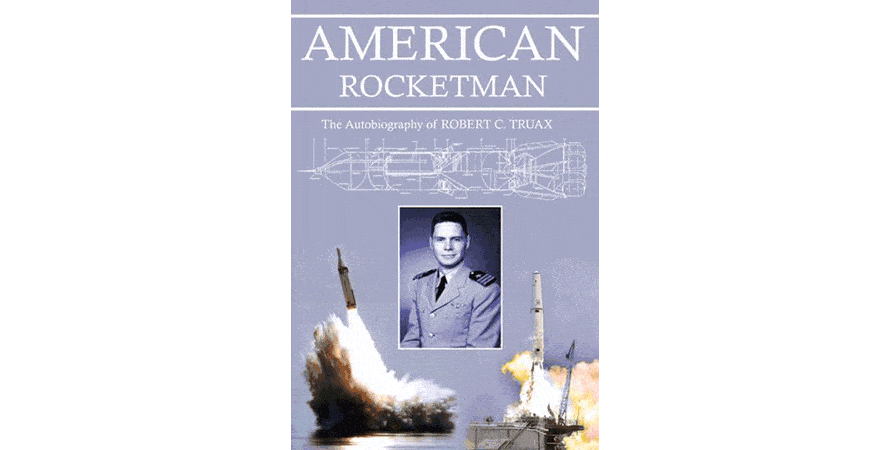Category: Nonfiction
Reviewed by: Clifford R. McMurray
Title: American Rocketman: The Autobiography of Robert C. Truax
Author: Robert Truax
NSS Amazon link for this book
Format: Paperback
Pages: 270
Publisher: Apogee Books
Date: January 2021
Retail price: $33.95
ISBN: 978-1989044155
No matter how many autobiographies you’ve read from individuals that make or fly rockets, I’ll wager you never read one that began with a sentence like “Mom was trudging down the trail, a single-action 12-gauge shotgun in the crook of her arm.” Robert Truax wants (wanted, since this autobiography was published more than a decade after his death) you to know that “at least one of the early birds of space is as American as the log cabin; I was raised in one.” He was born in 1917, just five years after Wernher von Braun, but whereas von Braun was born into Prussian aristocracy, Truax grew up dirt poor, in the most literal sense of that term. His father rode the rails as a hobo before settling down, and never had much money. He and his wife, for want of better alternatives, took Truax and his brother to homestead in the backwoods of California. Robert’s description of his childhood reads like something out of Grapes of Wrath.
A childhood like this makes a boy independent and self-sufficient. Given a brain to go with these virtues, he will go far if given half a chance. Truax won an appointment to the Naval Academy, and was launched on a career in the navy and private industry that lasted seven decades, through the pioneering days of rocketry and up to the dawn of the age of spacefaring civilization. That age of space commerce and settlement was a dream that captured him while he was still a midshipman at the Academy. He persuaded his instructors to allow him to build a test stand and rocket engine on his own time, and continued that interest after graduation. One of the few naval officers who knew anything at all about rockets, in World War II he was tapped to work on JATOs, rocket assisted takeoff for airplanes. In the naval engineering labs he rubbed shoulders with Robert Goddard, who had a civilian contract for the same thing. After the war he worked on ICBMs.
These days Truax is all but forgotten to everyone but space historians, but he deserves to be remembered not only for the contributions he made to rocket engine development (he laments that he didn’t take out a patent on a turbopump combustion cycle that was eventually used on the Space Shuttle, which would have made him a millionaire), but for his tenacity in pursuit of very simple, very robust technology that would radically lower the cost of getting to space. Had he ever persuaded the navy or any major aerospace contractor to build his “big dumb booster” called Sea Dragon (it would have been launched from a partially submerged position in the ocean), we might have seen the sort of payloads and cost performance promised by Elon Musk’s Starship decades earlier.
After he retired from the navy and set up his own small private contracting outfit, Truax pursued contracts with the navy, and nearly went bankrupt in the process. Readers of this book will find it hard to escape the conclusion that bureaucracies are where good ideas go to die. On the side, he got involved with motorcycle stuntman Evel Knievel, who wanted to jump the Grand Canyon, but settled for the Snake River Canyon. Although the attempt failed, Knievel survived; meanwhile, Truax had designed a Volksrocket with which he proposed to make Knievel the first private astronaut, if he could raise one million dollars for construction. Knievel only managed to put up a small fraction of that amount, so Truax spent the next several years trying to raise the money himself. He already had the engines for the rocket: four steering engines from an Atlas missile that he picked up from a salvage yard!
This book won’t be to everyone’s taste. Truax spends as much time telling the reader about his childhood and naval career as he does about rockets. Nevertheless, readers with a taste for the voice of a good raconteur will find Truax’s story engaging, and at times hilarious. It’s a story that reads like a novel. One pioneer’s life, from start to finish.
© 2021 Clifford R. McMurray
Please use the NSS Amazon Link for all your book and other purchases. It helps NSS and does not cost you a cent! Bookmark this link for ALL your Amazon shopping!




















1 thought on “Book Review: American Rocketman”
What a biography ! Thank you so much for allow us to learn from this pioneer. A book for all.